Household products company Spectrum Brands (NYSE:SPB) reported Q1 CY2024 results exceeding Wall Street analysts' expectations, with revenue down 1.5% year on year to $718.5 million. It made a non-GAAP profit of $1.62 per share, improving from its loss of $0.14 per share in the same quarter last year.
Spectrum Brands (SPB) Q1 CY2024 Highlights:
- Revenue: $718.5 million vs analyst estimates of $708.6 million (1.4% beat)
- Adjusted EBITDA: $62.3 million vs analyst estimates of $60.0 million (3.8% beat)
- Guidance for full year revenue now flat compared to 2023 (previously expected a decline)
- Gross Margin (GAAP): 38.1%, up from 29.5% in the same quarter last year
- Free Cash Flow was -$9 million compared to -$12.7 million in the previous quarter
- Organic Revenue was down 1.6% year on year
- Market Capitalization: $2.56 billion
A leader in multiple consumer product categories, Spectrum Brands (NYSE:SPB) is a diversified company with a portfolio of trusted brands spanning home appliances, garden care, personal care, and pet care.
The company’s history traces back to the early 20th century when it was originally founded as the "U.S. Electrical Manufacturing Company" in 1906, playing a key role in the development of the first electrically lit Christmas tree lights. In 1955, it changed its name to Rayovac Corporation and merged with Spectrum Brands in 2005 to form the company we know today.
Spectrum Brands’s portfolio was largely built up via acquisitions and now includes household names such as Black + Decker in home appliances, Spectracide in lawn and garden care, Nature's Miracle in pet care, and Remington in personal care. The company continues to be quite acquisitive and seeks to buy complementary brands, allowing it to enter new markets, benefit from synergies, and adapt to changing consumer preferences.
Spectrum Brands has a global footprint and its products are available in North America, Europe, Latin America, and other select markets, making it a significant player in the global consumer goods industry. It sells its products through various channels, including e-commerce and retail partnerships with companies like Best Buy and The Home Depot.
Household Products
Household products stocks are generally stable investments, as many of the industry's products are essential for a comfortable and functional living space. Recently, there's been a growing emphasis on eco-friendly and sustainable offerings, reflecting the evolving consumer preferences for environmentally conscious options. These trends can be double-edged swords that benefit companies who innovate quickly to take advantage of them and hurt companies that don't invest enough to meet consumers where they want to be with regards to trends.
Competitors include General Electric (NYSE:GE) in home appliances, Central Garden & Pet (NASDAQGS:CENT) in pet care, Scotts Miracle-Gro (NYSE:SMG) in lawn and garden care, and Procter & Gamble (NYSE:PG) in personal care.Sales Growth
Spectrum Brands carries some recognizable brands and products but is a mid-sized consumer staples company. Its size could bring disadvantages compared to larger competitors benefiting from better brand awareness and economies of scale. On the other hand, Spectrum Brands can still achieve high growth rates because its revenue base is not yet monstrous.
As you can see below, the company's revenue has declined over the last three years, dropping 7.5% annually. This is among the worst in the consumer staples industry, where demand is typically stable.
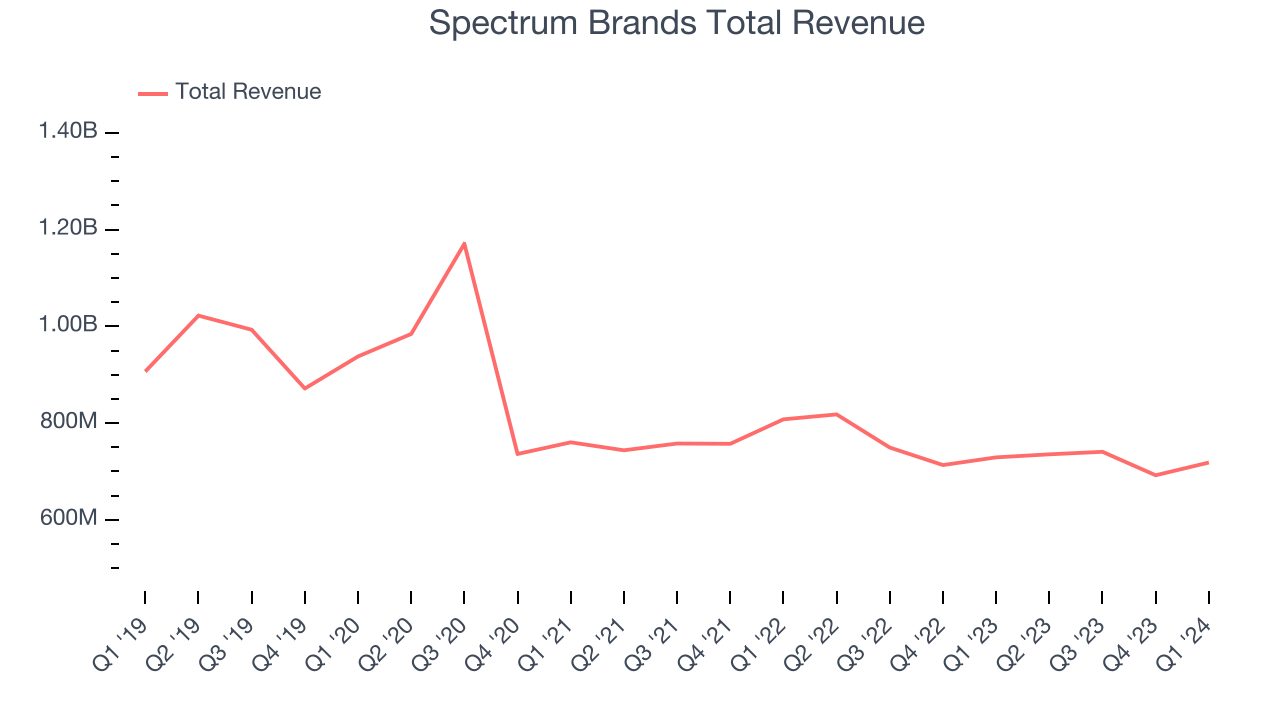
This quarter, Spectrum Brands's revenue fell 1.5% year on year to $718.5 million but beat Wall Street's estimates by 1.4%. Looking ahead, Wall Street expects revenue to remain flat over the next 12 months.
Organic Revenue Growth
When analyzing revenue growth, we care most about organic revenue growth. This metric captures a business's performance excluding the impacts of foreign currency fluctuations and one-time events such as mergers, acquisitions, and divestitures.
Spectrum Brands's demand has been falling over the last eight quarters, and on average, its organic sales have declined by 5.1% year on year.
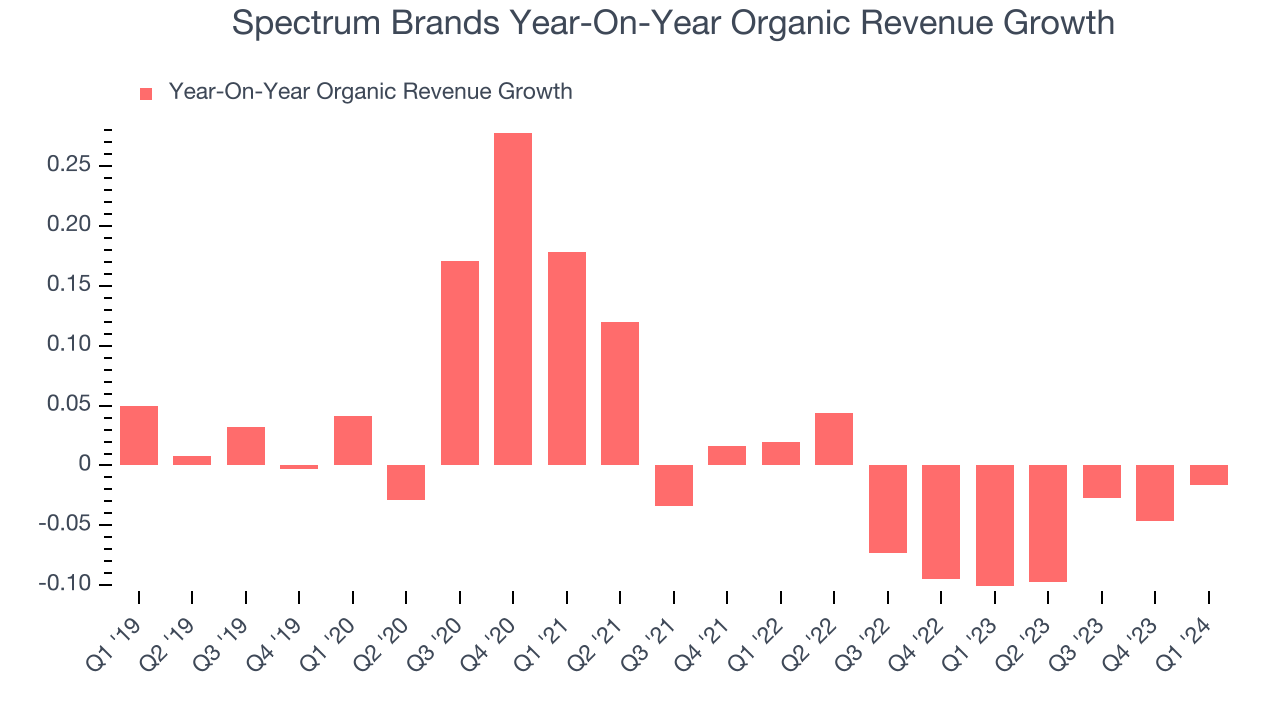
In the latest quarter, Spectrum Brands's organic sales fell 1.6% year on year. This decrease was an improvement from the 10.1% year-on-year decline it posted 12 months ago. It's always great to see a business improve its prospects.
Gross Margin & Pricing Power
All else equal, we prefer higher gross margins. They make it easier to generate more operating profits and indicate that a company commands pricing power by offering more differentiated products.
Spectrum Brands's gross profit margin came in at 38.1% this quarter, up 8.6 percentage points year on year. That means for every $1 in revenue, $0.62 went towards paying for raw materials, production of goods, and distribution expenses.
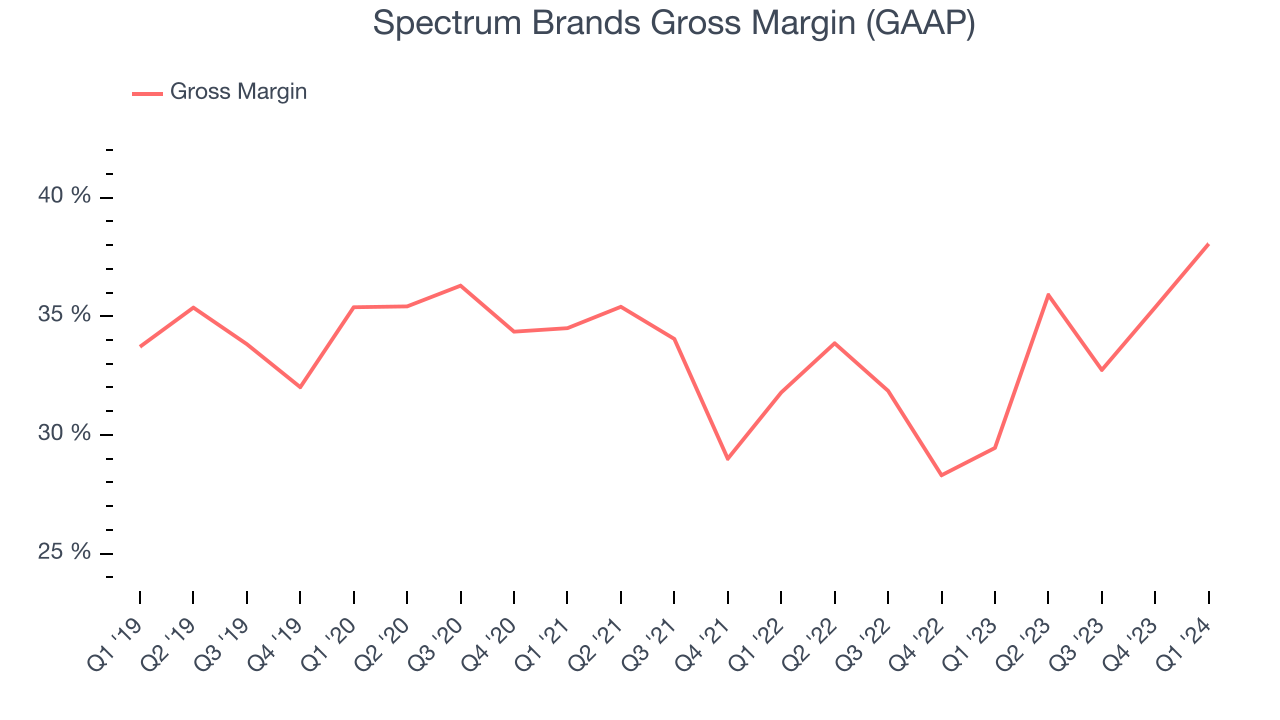
Spectrum Brands's unit economics are higher than the typical consumer staples company, giving it the flexibility to invest in areas such as marketing and talent to reach more consumers. As you can see above, it's averaged a decent 33.2% gross margin over the last eight quarters. Its margin has also been trending up over the last 12 months, averaging 15.7% year-on-year increases each quarter. If this trend continues, it could suggest a less competitive environment where the company has better pricing power and more favorable input costs (such as raw materials).
Operating Margin
Operating margin is an important measure of profitability accounting for key expenses such as marketing and advertising, IT systems, wages, and other administrative costs.
In Q1, Spectrum Brands generated an operating profit margin of 10.6%, up 21.1 percentage points year on year. This increase was encouraging, and we can infer Spectrum Brands was more efficient with its expenses because its operating margin expanded more than its gross margin.
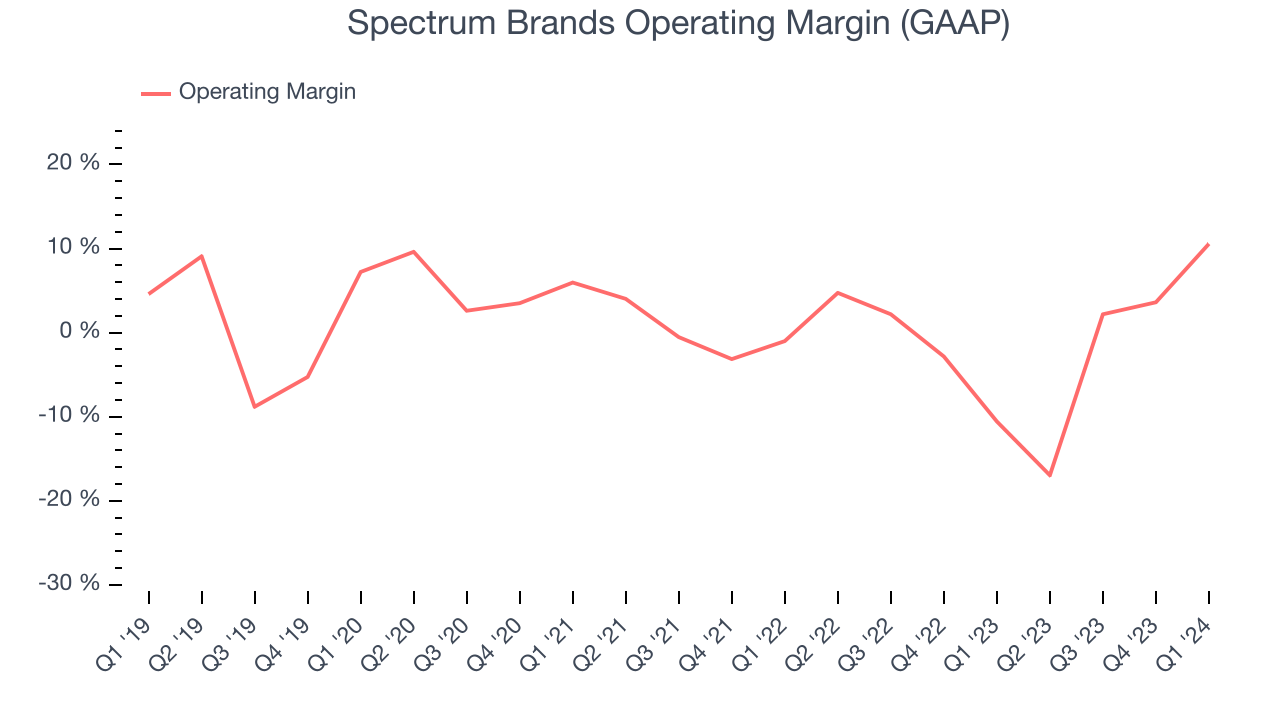 Zooming out, Spectrum Brands was roughly breakeven when averaging the last two years of quarterly operating profits, weak for a consumer staples business. However, Spectrum Brands's margin has improved by 1.1 percentage points on average over the last year, showing the company is heading in the right direction.
Zooming out, Spectrum Brands was roughly breakeven when averaging the last two years of quarterly operating profits, weak for a consumer staples business. However, Spectrum Brands's margin has improved by 1.1 percentage points on average over the last year, showing the company is heading in the right direction.EPS
These days, some companies issue new shares like there's no tomorrow. That's why we like to track earnings per share (EPS) because it accounts for shareholder dilution and share buybacks.
In Q1, Spectrum Brands reported EPS at $1.62, up from negative $0.14 in the same quarter a year ago. This print easily cleared Wall Street's estimates, and shareholders should be content with the results.
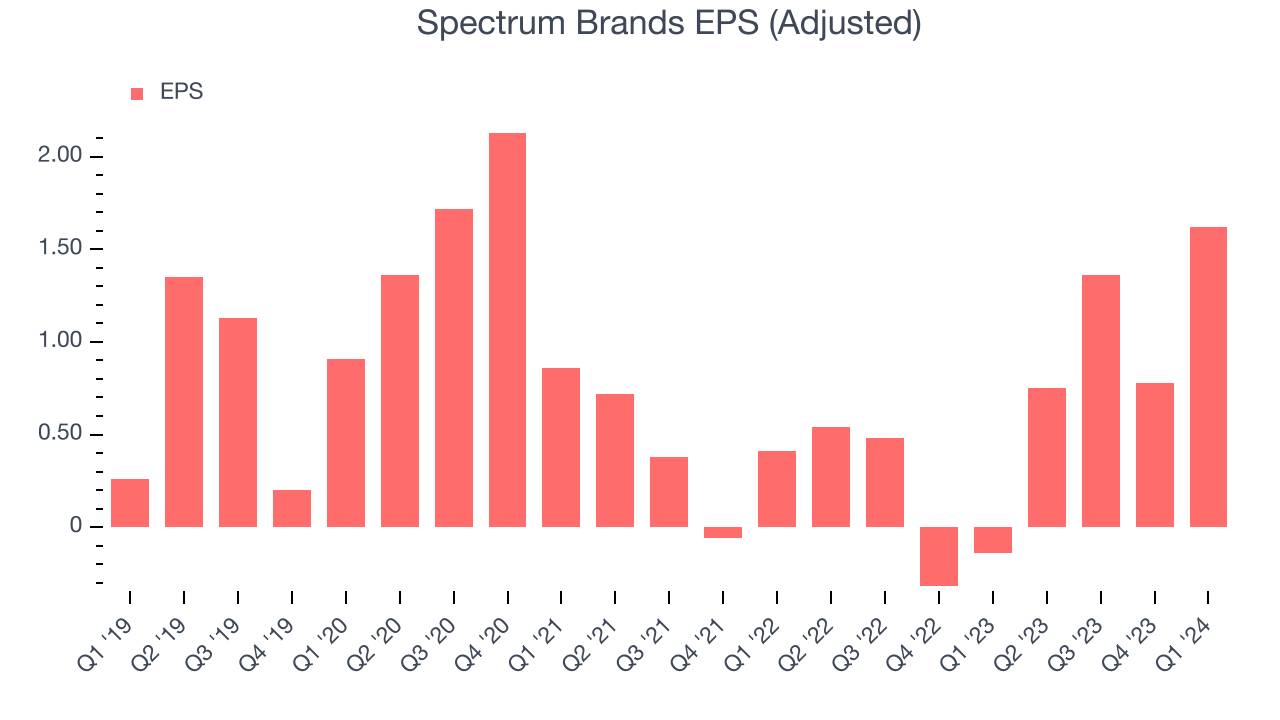
Between FY2021 and FY2024, Spectrum Brands's EPS dropped 25.7%, translating into 9.4% annualized declines. We tend to steer our readers away from companies with falling EPS, especially in the consumer staples sector, where shrinking earnings could imply changing secular trends or consumer preferences. If there's no earnings growth, it's difficult to build confidence in a business's underlying fundamentals, leaving a low margin of safety around the company's valuation (making the stock susceptible to large downward swings).
Wall Street expects Spectrum Brands to continue performing poorly over the next 12 months, with analysts projecting an average 8.8% year-on-year decline in EPS.
Cash Is King
Although earnings are undoubtedly valuable for assessing company performance, we believe cash is king because you can't use accounting profits to pay the bills.
Spectrum Brands burned through $9 million of cash in Q1, representing a negative 1.3% free cash flow margin. The company shifted to cash flow negative from cash flow positive in the same quarter last year, which caught our eye as we'd like consumer staples companies to have more consistent performance.
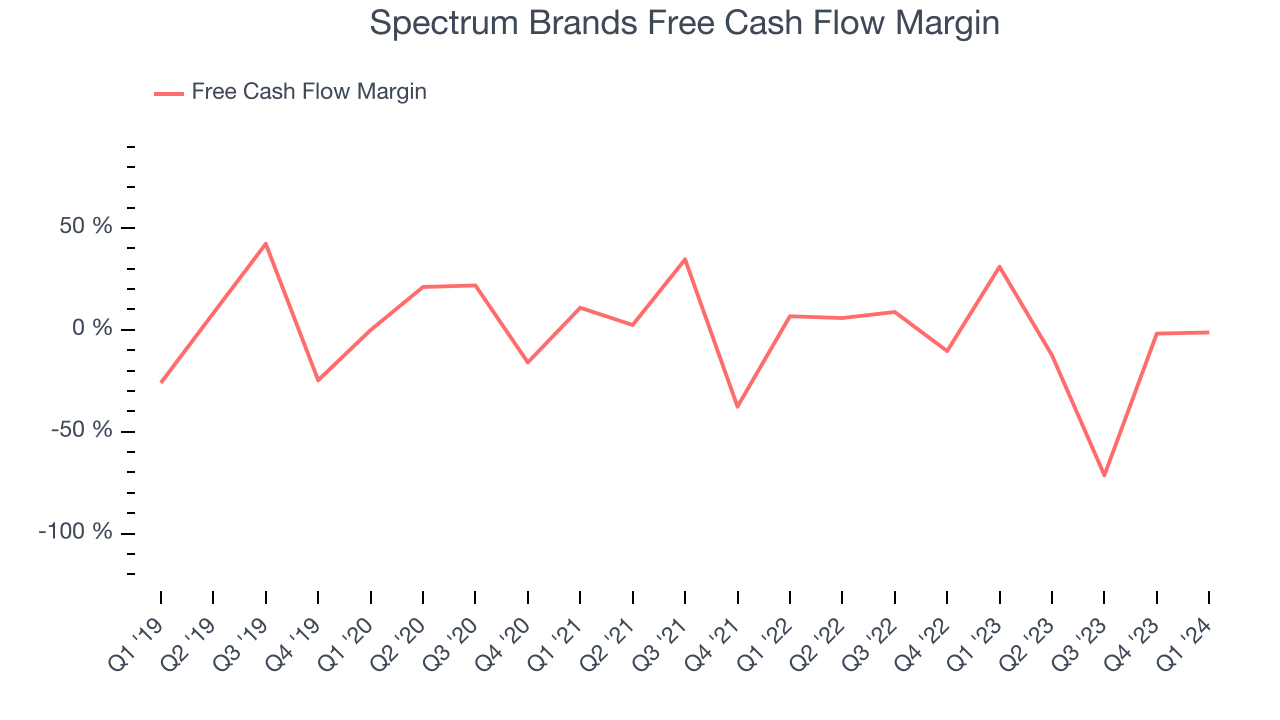
Over the last two years, Spectrum Brands's demanding reinvestment strategy and failure to generate organic revenue growth have drained company resources. Its free cash flow margin has been among the worst in the consumer staples sector, averaging negative 6.4%. Furthermore, its margin has averaged year-on-year declines of 31 percentage points over the last 12 months. Its cash profitability could drop even further as Spectrum Brands may try to stimulate organic growth through more investments. We've no doubt shareholders would like to see an improvement soon.
Return on Invested Capital (ROIC)
EPS and free cash flow tell us whether a company was profitable while growing revenue. But was it capital-efficient? Enter ROIC, a metric showing how much operating profit a company generates relative to how much money the business raised (debt and equity).
Spectrum Brands's five-year average ROIC was 0.6%, somewhat low compared to the best consumer staples companies that consistently pump out 20%+. Its returns suggest it historically did a subpar job investing in profitable business initiatives.
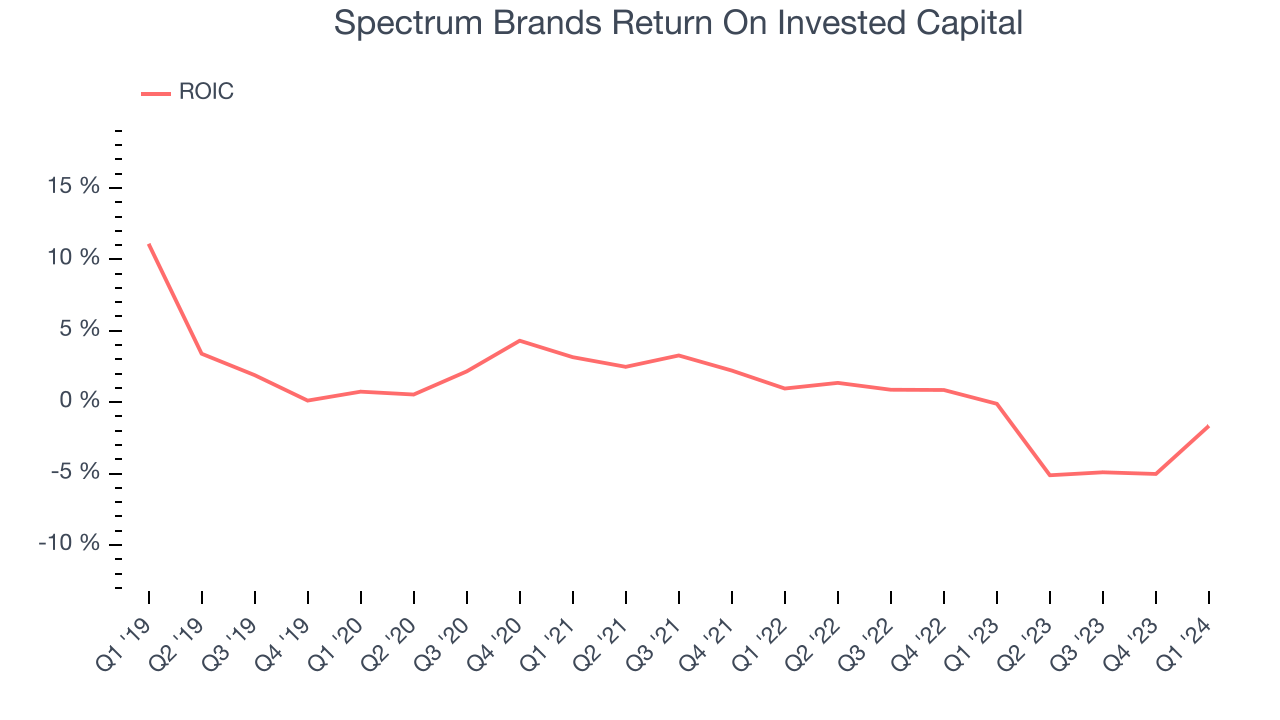
The trend in its ROIC, however, is often what surprises the market and drives the stock price. Unfortunately, Spectrum Brands's ROIC averaged 2.8 percentage point decreases over the last few years. Paired with its already low returns, these declines suggest the company's profitable business opportunities are few and far between.
Key Takeaways from Spectrum Brands's Q1 Results
We liked seeing Spectrum Brands beat analysts' EPS expectations this quarter. We were also excited its gross margin outperformed Wall Street's estimates. Lastly, the company raised its full year revenue outlook, now expecting it to be flat vs. 2023 compared to a prior expectation of a sales decline. Zooming out, we think this was a solid quarter. The stock is flat after reporting and currently trades at $84.52 per share.
Is Now The Time?
Spectrum Brands may have had a good quarter, but investors should also consider its valuation and business qualities when assessing the investment opportunity.
We cheer for all companies serving consumers, but in the case of Spectrum Brands, we'll be cheering from the sidelines. Its revenue has declined over the last three years, but at least growth is expected to increase in the short term. And while its gross margins indicate a healthy starting point for the overall profitability of the business, the downside is its cash burn raises the question of whether it can sustainably maintain growth. On top of that, its relatively low ROIC suggests it has struggled to grow profits historically.
Spectrum Brands's price-to-earnings ratio based on the next 12 months is 20.5x. While we've no doubt one can find things to like about Spectrum Brands, we think there are better opportunities elsewhere in the market. We don't see many reasons to get involved at the moment.
Wall Street analysts covering the company had a one-year price target of $92.88 per share right before these results (compared to the current share price of $84.52).
To get the best start with StockStory, check out our most recent stock picks, and then sign up to our earnings alerts by adding companies to your watchlist here. We typically have the quarterly earnings results analyzed within seconds of the data being released, and especially for companies reporting pre-market, this often gives investors the chance to react to the results before the market has fully absorbed the information.
